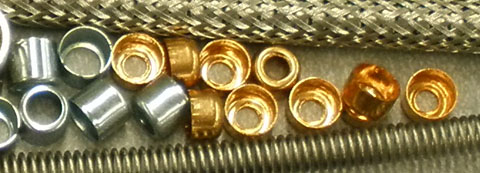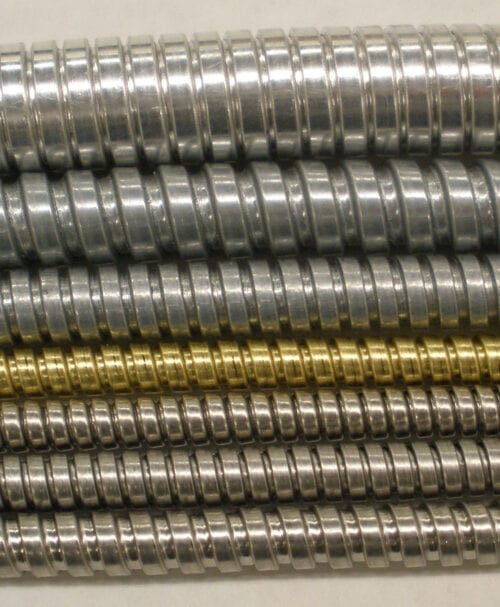What are Benefits of Liquid Tight Jackets on Hose?
Leave a CommentANAMET Industrial Solutions applies a variety of jackets to our metal hose.
Jacket Materials
Our American suppliers provide us with PVC, TPE, TPU, Silicone and other materials. Custom formulations preserve liquid tight, flexible features while meeting stringent industrial demands. These jackets resist degradation in harsh environments.
Rigorous testing, experimentation and development are ongoing. We improve safety, meet regulatory standards and exceed the target needs of industry.
History of Success
We have a history of supporting new technology and meeting safety standards.
- In World War II, when the U.S. Navy asked for a liquid tight jacket on metal hose, we delivered the first liquid tight PVC jacket.
- In 1945, our liquid tight hose, Type HTCD (high temperature shielding conduit), was installed on piston-engine airplanes to enable in-flight radio and radar for the war and afterwards.
- In 1949, when the National Electrical Code allowed use of flexible, liquid tight metal conduit, we won Underwriters’ Laboratories (UL) listing for ANACONDA SEALTITE® with a PVC jacket on metal hose.
- In 1963, when customers needed hose to be flexible and liquid tight in high and low temperatures, we delivered hot- and cold-resistant jackets.
- In 1967, when customers needed hose that is resistant to oil and grease exposure, we delivered oil resistant jackets.
- In 1980, we introduced liquid tight jackets on hose suitable for installation under raised floors for information technology.
- In 1981, we offered a jacket that extended flexibility and protection in extreme hot and cold conditions.
- In 1985, to prevent toxic fumes (chlorine and fluorine), we developed Halogen free jackets and avoided fluorine-based jackets on our products.
- In 1986, we tested our jackets to make sure they met expanded industry standards for UV (sunlight) resistance.
- In 1992, we delivered a highly flexible jacket on metal hose, Machine Tool Conduit (type MTC). This jacket provides strain relief for wires repeatedly bent to a tight radius.
- In 2002, we delivered a low smoke, Halogen free jacket. Since then, we developed more low smoke, Halogen free options.
- In 2013, we delivered a Food Grade hose and jacket meeting NSF requirements, which is antibacterial, easily cleaned and resistant to soap and detergent.
- In 2023, we delivered an anti-static jacket that meets the NEN-EN-IEC 600079-0 Section 26-13 anti-static surface resistivity requirement of less than 1 billion (thousand million) Ohms.
Color and Print Options
Apart from meeting these safety and operational needs, we offer:
-
Color options that meet these requirements:
- Identify safety circuits
- Meet color code safety requirements
- Match corporate identity colors
- Match pleasing decor in exposed locations
-
Custom print on hose jackets deliver these options:
- Promote brand recognition with a message
- Mark hose with a brand name
- Show corporate part numbers for easy identification
- Display a safety code on the hose jacket
- Describe acceptable use for safe installation
Liquid Tight Fittings
Our liquid tight jacket on metal hose supports installation of liquid tight fittings. The fitting grips the polymer jacket on a hose for a liquid tight connection.
Our fittings have polymer seals and compressing action that fulfill industry requirements for an IP 66/67 rating. Dust and moisture are kept away from hose content.
For more information about IP rating, see our whitepaper on the subject.
Assistance with Hose Jackets and Requirements
ANAMET Industrial Solutions personnel have experience delivering millions of feet of jacketed metal hose for industry worldwide.
We are familiar with the demands of jacketed metal hose production and installation. Our customers benefit from our experience in producing flexible, liquid tight metal hose. We want to help you succeed. Please contact us if your product includes flexible metal hose.
If you already know your metal hose requirements, please use our Conduit Request Form.
What are Some Challenges of Terminating Metal Hose?
Leave a CommentANAMET Industrial Solutions produces thousands of feet of metal hose. No matter the diameter or material of metal hose, cutting hose to a prescribed length can result in a ragged edge. Deburring and fitting installation overcomes this ragged edge.

Cutting hose results in sharp edges, no matter the hose material
Demands of Flexible Hose
Compression and extension in metal hose adds complexity to cutting, deburring and termination operations. Since the hose is pushed or pulled to the saw during the cutting process, the hose length can vary after cutting. Like pushing a chain uphill, there is more than meets the micrometer. Something always slides.
Metal hose is flexible with elastic coils resulting from roll forming metal strip
Deburring
Deburring is a subtractive process, removing material from the hose, breaking sharp edges. Deburring rounds the sharp edges on the inner and outer edges of the hose end. Deburring operations must be kept to strict tolerances to sustain prescribed hose lengths. This is more than just “measure twice and cut once.”
Terminations
Installing connectors on the metal hose is an additive process, with different challenges. Hose terminating parts are intended to protect hose contents and provide strain-free connection at the joint. Putting a terminating part on a round hose decreases the inner diameter and increases the outer diameter at the hose end. Fittings go over the lip of the hose, terminating hose with a threaded boss, brazing, welding, gluing, deformable collars, and compression or swaging of a ferrule. These options increase diameter.
Ferrules are a metal cap with a hole in the top. The ferrule encloses the lip of the hose, however inconsiderate compression and swaging can deform the hose end to a hexagon, square or oval shape.

Ferrules are available in various materials, with locking features as needed
Tolerances
Attention to tolerance makes up for the demands of different manufacturing processes. Allowances are also made within the restrictions of speed, cost and quality outcome. Because quality is sometimes equated with precision measurement, experience in the metal working industry shows that every thousandth of an inch in precision doubles production costs (How Dimensional Tolerances Impacts Part Production Costs | Keller (kellertechnology.com). Accounting for manufacturing limitations and opportunities prevents surprises and quality failures. Knowing how much variation is acceptable (allowable tolerance versus tight tolerance) can enable delivery of an affordable product that meets design requirements.
Design Development
Since there are many complex factors in creating quality metal hose, here are some considerations for design development:
- Are there strict material requirements for the metal hose and termination?
- Corrosion Resistance
- Ground Path
- Non-Ferrous
- Must all edges be broken to avoid exposure of sharp edges? Deburring and burnishing may be required.
- Must hose and fittings meet a regulatory requirement?
- What termination method fulfills design requirements?
- How much flexibility is needed in the hose and terminals?
- What is the total length needed for hose and terminals?
- Is the tolerance stack-up for the hose and termination loose or restricted?
- Must the hose and termination fit in a confined space?
- How much may the inner diameter of the hose be decreased by the termination?
- How much may the outer diameter of the hose be increased by the termination?
Assistance with Metal Hose Features and Requirements
ANAMET Industrial Solutions personnel have experience delivering millions of feet of metal hose for industry worldwide. We are familiar with the demands of metal hose production and installation. Our customers have benefitted from our experience in custom cut length and termination of flexible metal hose, installing custom ferrules, threaded fittings, bayonet fittings and cord grips.
We want to help you succeed. Please contact us if your product includes flexible metal hose.
If you already know your metal hose requirements, please use our Conduit Request Form.




